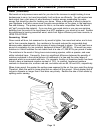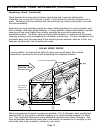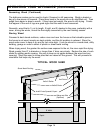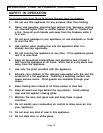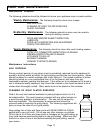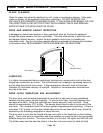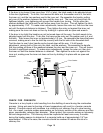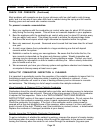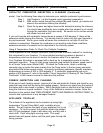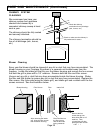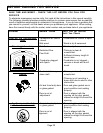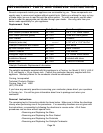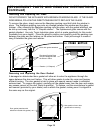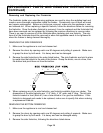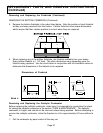
Page 20
CARE AND MAINTENANCE (Continued)
CHECK FOR CREOSOTE (Continued)
Most problems with creosote are due to poor chimneys with low draft and/or cold chimney
walls, and to a low rate of burn when little heat is needed during the spring and fall months.
Burning green and wet wood also creates creosote.
To prevent creosote accumulation:
1. Burn your appliance with the combustion air control wide open for about 20-30 minutes
daily during the burning season. This will burn out creosote deposits in your appliance.
2. Burn the appliance with the combustion air control wide open for about 20 minutes every
time you apply fresh wood. This allows the wood to achieve the charcoal stage faster
and burns the wood vapors which might otherwise be deposited within the system.
3. Burn only seasoned, dry wood. Seasoned wood is wood that has been dried for at least
one year.
4. A small, more intense fire is preferable to a large smoldering one that will deposit
creosote within the system.
5. Establish a routine for using your new appliance. Be aware that the hotter the fire, the
less creosote is deposited on the glass and chimney system. Weekly inspection and
cleaning may be necessary during times of heavy appliance usage. Contact your local
fire authority for information on how to handle a chimney fire. Have a clearly understood
plan to handle such a fire.
6. We recommend you have your chimney system and appliance checked and cleaned by
a competent chimney sweep at least once a year.
CATALYTIC COMBUSTOR INSPECTION & CLEANING
It is important to periodically monitor the operation of the catalytic combustor to insure that it is
functioning properly and to determine when it needs to be cleaned or replaced. A non-
functioning combustor will result in a loss of heating efficiency and an increase in creosote
and emissions. The following is a list of ways to monitor the catalytic combustor.
Visual Inspection & Cleaning Of The Catalytic Combustor
Combustors should be visually inspected before and after each heating season to determine
if physical degradation has occurred. Removal of the mixing screen in front of the combustor
is required for this inspection. Refer to the "REPLACEMENT PARTS AND REMOVAL
INSTRUCTIONS" section of this owner's manual for removal instructions. Do not remove the
catalyst from the combustor assembly unless it needs replacement because it is fragile.
Check the combustor for plugging. If the front of the combustor and/or mixing screen is
covered with a fine dust plugging some of the openings, either vacuum it or use a soft paint
brush to brush off the dust. Check to see if the combustor is cracked, broken , or deteriorated.
Replace the combustor if damaged (available at your dealer).
Periodic Inspection Of Catalytic Combustor Performance
To get an indication of whether the catalyst is working, compare the amount of smoke leaving
the chimney when the smoke is being routed through the combustor to the amount of smoke
leaving the chimney when the smoke is not routed through the combustor (by-pass open



